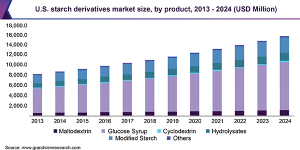Cold-water-soluble (CWS) starches is prepared by alcoholic-alkaline treatments. The method iss carried out by treating starches with mixtures of ethanol and alkali, primarily NaOH solution (3M), to swell starch granules. The treated starches are then neutralized with HCl (3M, in 100% alcohol), washed with aqueous alcohol solution, and dried in an oven at 80°C for 3 h. The method is effective to wide varieties of starches, including high amylose starches, normal starches, and waxy starches. The efficacy of the method depended mainly on concentrations of NaOH and ethanol, and reaction temperature. Different reaction conditions gave products different properties; Light microscopy revealed that the GCWS starches retained intact but indented granules. The GCWS starch granules showed no Maltese cross when examined by a microscope under polarized light. The x-ray diffraction patterns of the GCWS starches were V types except the GCWS waxy maize starch, which was amorphous.
Related Project: Cold Water Soluble Starch

The GCWS starches showed fully swollen granules when dispersed in cold water and exhibited about 70% to 90% of cold-water solubility. Most of the GCWS starch pastes displayed higher viscosity and better freeze-thaw stability than their native counterparts; Controlled release of atrazine encapsulated in GCWS starch matrices was found effective. The study showed that atrazine was physically embedded in starch matrices. Use of GCWS Hylon VII starch as an encapsulated material showed the best encapsulation efficiency. The release rate of atrazine in aqueous ethanol solution (10%, v/v) was affected by the amylose content of the starch, particle sizes, and the temperature. Atrazine encapsulated in high-amylose maize starch matrix displayed a slow release rate. Small particles of encapsulated atrazine product had a fast release rate. In addition, high release temperature tended to increase release rate of encapsulated atrazine. Changes of pH in this study had no significant effect on the release rate of atrazine.
Book Link: Handbook on Maize (Corn) Processing and Manufacture of Maize Products
Highest Utilization in Bakery Industry Proliferating:
Cold water swelling starch is a specialty starch which is ideal for the baking industry. Cold water swelling starch provides smooth texture with the increased creaminess to the end product without altering or masking the flavor of the end product or the components of the end product. This characteristic of cold water swelling starch enables producers to control the flavor of the product more easily while satisfying the consumer need.
Related Videos: Starch & its Derivatives
High tolerance of cold water swelling starch to the process condition enables end product such as baked potato chips possesses smoother appearance as well as crispiness fulfilling consumer demand. Cold water swelling starch in an instant food does not form any clumps floating on the liquid surface and provides stability, clarity, and texture in the end product which is desirable qualities.
Global Cold Water Swelling Starch Market: Key Developments

Related Book: The Complete Technology Book on Starch and Its Derivatives
Cold water swelling starch to bakeries in the Asia region. With this introduction, CWS starches offer significant potential for innovation and future application in regional food and beverage industry, particularly in bakeries. Research in the storage facility and conditions of raw material is an important aspect due to increased demand for cold water swelling starch. Innovation and research in the improvement of a novel product to provide instant or ready-to-eat with premium quality ingredients has increased the demand for cold water swelling starch. For example; in multigrain cookies adopting cold water swelling starch instead of conventional starch, grain quality is enhanced along with retained moisture and greater room to control texture. Improvement in dough processing and machinability due to better rheology benefits food manufacturers to transcend the production stages.
Conclusion:
NIIR project consultancy services (NPCS) have written a project report on “Cold Water Soluble Starch” where each segment of the industry is discussed and explained properly. A few of the topics that are covered in the project report are the manufacturing of chemicals, purification of the product, and efficiency of the product. The book has proven to be a great help to new entrepreneurs, industrialists, research scholars, technical libraries, consultants, etc. to understand the industry correctly.
Noo_Art2021
#DetailedProjectReport #businessconsultant #BusinessPlan #feasibilityReport #NPCS #industrialproject #entrepreneurindia #startupbusiness #BusinessIdeas #StartupBusinessIdeas #BusinessOpportunity #Solublestarch #ColdWaterSoluble #StarchBusiness #StarchMarket #StarchIndustry #StarchProduction